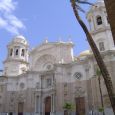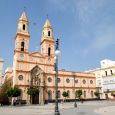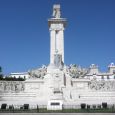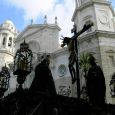Cadiz
Advertisement
By plane
The closest airport is Jerez de la Frontera, about 30 minutes by car or taxi (fixed price €46), 1 hour by direct bus, though there are few buses and the schedules do not fit most flights. There are several daily flights to Madrid and Barcelona (Iberia, Spanair, Vueling). Ryanair flies daily to London Stansted and Frankfurt Hahn. Other operators fly scheduled, charter, or seasonal flights. The nearest major airports are in Sevilla (1 hour by car, 2 hours by bus or train) and Malaga (2-3 hours by car or bus).
By train
Frequent trains run to Jerez and about hourly to Seville. A very convenient way to come in from Madrid is with the Talgo train that runs twice a day covering the distance in about 5 hours.
From Jerez to Cadiz fares are only 5€ for an adult and 3€ for a child
By Boat
Cruise ships often dock within easy walking distance of the old city/downtown. Passengers also can take day trips to Seville (about two hours by bus) or Jerez De La Frontera (less than 1 hour by bus). There are frequent commuter ferries to Rota and Puerto de Santa Maria
By car
From Madrid, Cordoba and Seville you can use the A4, from Barcelona N340. A taxi ride from Jerez de la Frontera to Cadiz costs about € 50.
Advertisement
Plaza de San Francisco and San Francisco Church and Convent
Located next to Plaza de Mina, this smaller square houses the San Francisco church and convent. Originally built in 1566, it was substantially renovated in the 17th century, when its cloisters were added. Originally, the Plaza de Mina formed the convent's orchard.
Plaza de la Catedral and the Cathedral
The Plaza de la Catedral houses both the Cathedral and the Baroque church of Santiago, built in 1635.One of Cadiz's most famous landmarks is its cathedral. It sits on the site of an older cathedral, completed in 1260, which burned down in 1596. The reconstruction, which was not started until 1776, was supervised by the architect Vicente Acero, who had also built the Granada Cathedral. Acero left the project and was succeeded by several other architects. As a result, this largely Baroque-style cathedral was built over a period of 116 years, and, due to this drawn-out period of construction, the cathedral underwent several major changes to its original design.
Plaza de Mina
Located in the heart of the old town, Plaza de Mina, (the most beautiful of the Cadiz plazas) was developed in the first half of the 19th century. Previously, the land occupied by the plaza was the orchard of the convent of San Francisco. The plaza was converted into a plaza in 1838 by the architect Torcuato Benjumeda and (later) Juan Daura, with its trees being planted in 1861. It was then redeveloped again in 1897, and has remained virtually unchanged since that time. It is named after General Francisco Espoz y Mina, a hero of the war of independence. Manuel de Falla y Matheu was born in Number 3 Plaza de Mina, where a plaque bears his name
Plaza de Candelaria
The Plaza de Candelaria is named after the Candelaria convent, situated in the square until it was demolished in 1873, when its grounds were redeveloped as a plaza. The plaza is notable for a statue in its centre of Emilio Castelar, president of the first Spanish republic, who was born in a house facing the square. A plaque situated on another house, states that Bernardo O'Higgins, an Irish-Chilean adventurer and former dictator of Chile also, lived in the square.
Plaza de Falla and the Gran Teatro Falla
The original Gran Teatro was constructed in 1871 by the architect García del Alamo, and was destroyed by a fire in August, 1881. The current theatre was built between 1884 and 1905 over the remains of the previous Gran Teatro. The architect was Adolfo Morales de los Rios, and the overseer of construction was Juan Cabrera de la Torre. The outside was covered in red bricks and is of a neo-Mudejar or Moorish revival style. Following renovations in the 1920s, the theatre was renamed the Gran Teatro Falla, in honor of composer Manuel de Falla, who is buried in the crypt of the cathedral. After a period of disrepair in the 1980s, the theatre has since undergone extensive renovation.
Information not available
Information not available
Advertisement








